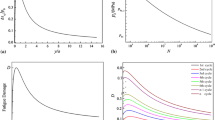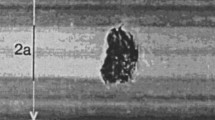Abstract
This paper proposed an approach for the subsurface rolling contact fatigue damage assessment of the component operated under rolling contact conditions. The maximum range of orthogonal shear stress was selected as the critical stress controlling subsurface rolling contact fatigue damage. The distribution of the maximum range of orthogonal shear stress combined with the S–N curve of materials tested was used to compute the subsurface rolling contact fatigue damage. The distribution of subsurface rolling contact fatigue damage computed by theoretical model proposed was validated by the statistical analysis result of hardness test on the rolling contact fatigue test samples and distribution of the pole figure’s peak intensity tested by X-ray diffraction method in one of the reference article. The theoretical results agree well with that subsurface rolling contact fatigue damage evaluation characterized by hardness and X-ray diffraction.








Similar content being viewed by others
References
D.F. Cannon, H. Pradier, Rail rolling contact fatigue Research by the European Rail Research Institute. Wear 191, 1–13 (1996)
H.R.B. Rad, A. Monshi, M.H. Idris et al., Premature failure analysis of forged cold back-up roll in a continuous tandem mill. Mater. Des. 32, 4376–4384 (2011)
G. Chattopadhyay, V. Reddy, P.O.L. Kraik, Decision on economical rail grinding interval for controlling rolling contact fatigue. Intl. Trans. Oper. Res. 12, 545–558 (2005)
M. Nakagawa, A. Asano, M. Fukushima, A. Hoshi, Effect of maintenance on backup roll life. Iron Steel Eng. 59, 23–27 (1982)
A.J. Liddle, K. Shinozuka, T. Nagamatsu, Hot Strip Mill Backup roll Performance Improvement Program by Joint Work Between BHP and JCFC (South East Asia Iron and Steel Institute, Kaohshiung, 1996)
M. Ishida, The effect of preventive grinding on rail surface shelling. Q. Rep. 39, 136–141 (1998)
R.K. Steele, The effect of metal removal, steel cleanliness and wheel load on the fatigue life of rail. Wear 144, 71–87 (1991)
J.W. Seo, B.C. Goo, J.B. Choi, Y.J. Kim, Effects of metal removal and residual stress on the contact fatigue life of railway wheels. Int. J. Fatigue 30, 2021–2029 (2008)
R.T. Lee, Y.C. Chiou, J.H. Chang, Effects of pre-rolling and metal removal on the fatigue life of lubricated rolling–sliding contact. Wear 217, 95–103 (1998)
Y. Akiniwa, S. Machiya, K. Tanaka, Fatigue damage evaluation in SiCp/2024 by X-ray diffraction method. Int. J. Fatigue 28, 1406–1412 (2006)
M. Mineur, P. Villechaise, J. Mendez, Influence of the crystalline texture on the fatigue behavior of a 316L austenitic stainless steel. Mater. Sci. Eng. A 286, 257–268 (2000)
M. Nagase, S. Shigenari, S. Hideaki, Some Investigations on the Fatigue Layer and Dressing Programme of Plate Finisher Mill Backup-Roll, in ISIJ, vol. 9 (1970), pp. 1201–1209
K. Kenji, S. Yukio, X-ray texture analysis on cyclic shearing deformation due to rolling contact fatigue. J. Soc. Mater. Sci. Jpn. 53, 300–305 (2004)
K. Kenji, I. Yasuo, S. Yukio, Texture development in surface layer of rail steel during rolling. J. Soc. Mater. Sci. Jpn. 37, 592–598 (1987)
K.L. Johnson, Contact Mechanics (Cambridge University Press, Cambridge, 1985)
E. McEwen, Stresses in elastic cylinders in contact along a generatrix. Philos. Mag. 40, 454 (1949)
R.D. Mindlin, Compliance of elastic bodies in contact. Trans. ASME. Ser. E J. Appl. Mech. 16, 259 (1949)
Z.H.A.O. Xianqiong, L.I.U. Yilun, H.O.N.G. Yuan, Contact stress analysis of rotary-support component under tractive rolling contact. Chin. J. Comput. Mech. 6, 966–972 (2009)
Acknowledgments
This work was supported by the Natural Science Foundation for Young Scientists of Shanxi Province, China (Grant No. 201701D221136), the Youth Foundation of Taiyuan University of Technology, China (Grant No. 2015QN005) and foundation of China’s National Scholarship Council (CSC No. 201606935050).
Author information
Authors and Affiliations
Corresponding author
Rights and permissions
About this article
Cite this article
Qin, Xf., Li, F. & Zhao, X. An Approach for Subsurface Rolling Contact Fatigue Damage Assessment of Backup Roll Material. J Fail. Anal. and Preven. 17, 942–947 (2017). https://doi.org/10.1007/s11668-017-0326-z
Received:
Revised:
Published:
Issue Date:
DOI: https://doi.org/10.1007/s11668-017-0326-z




